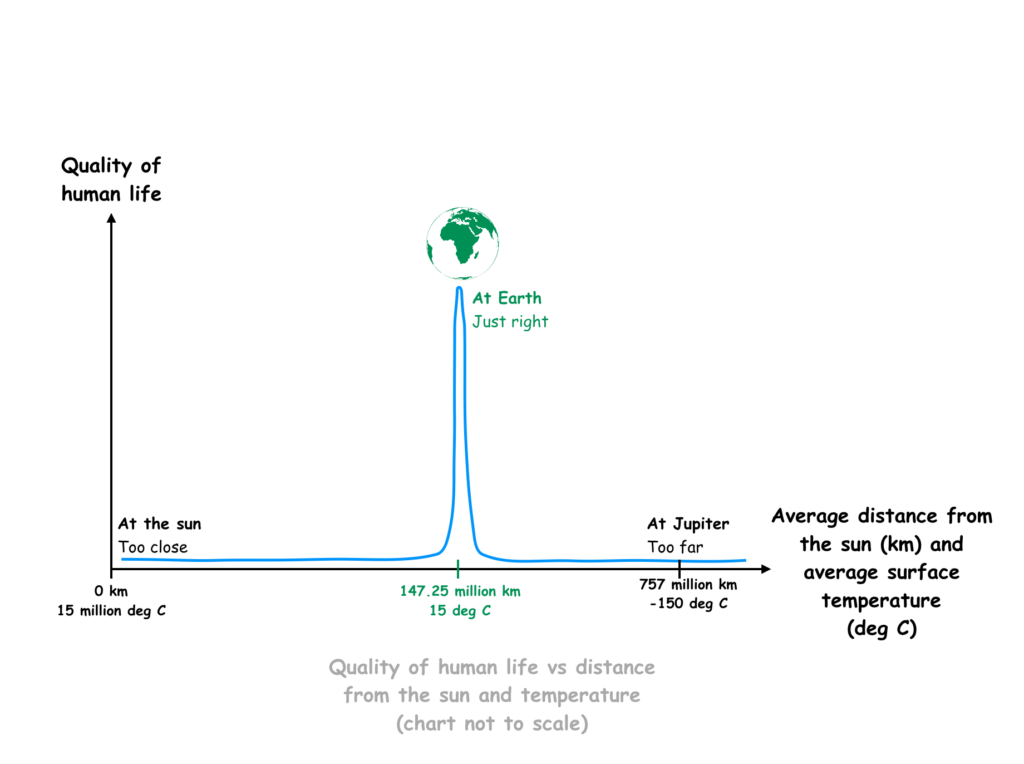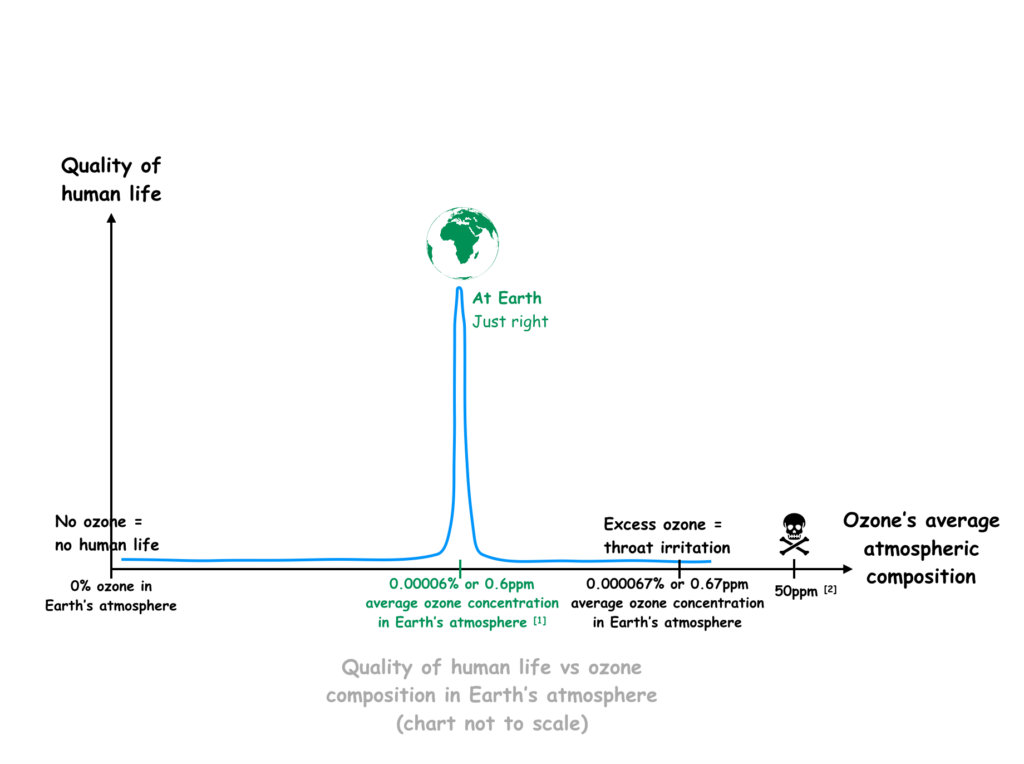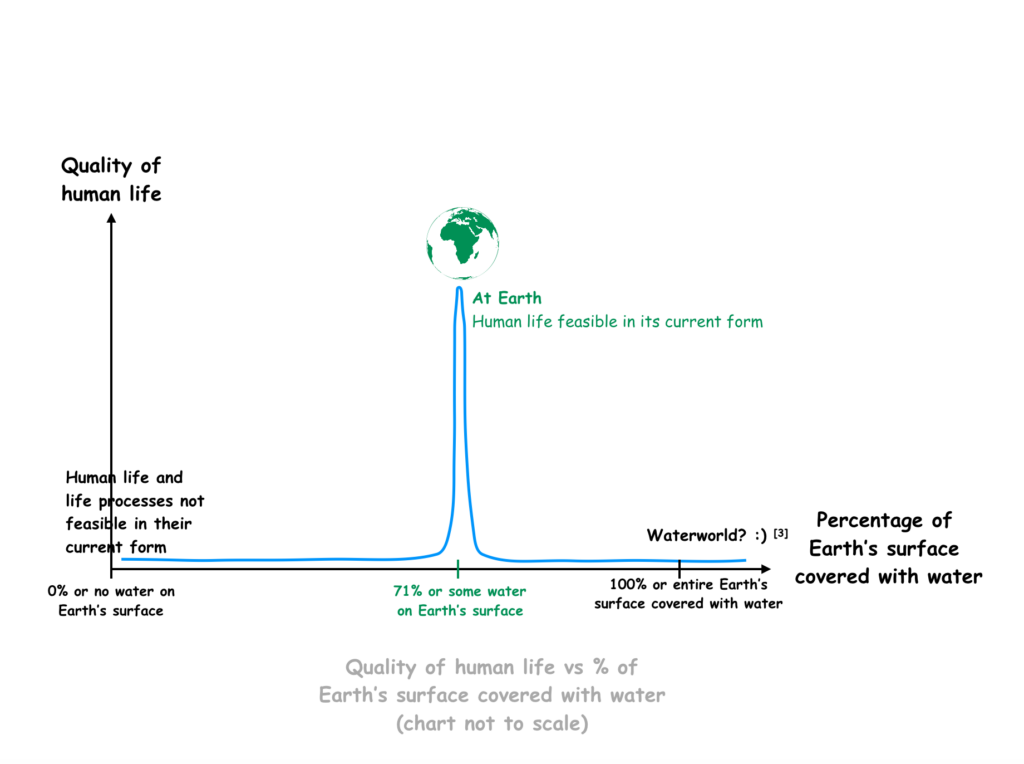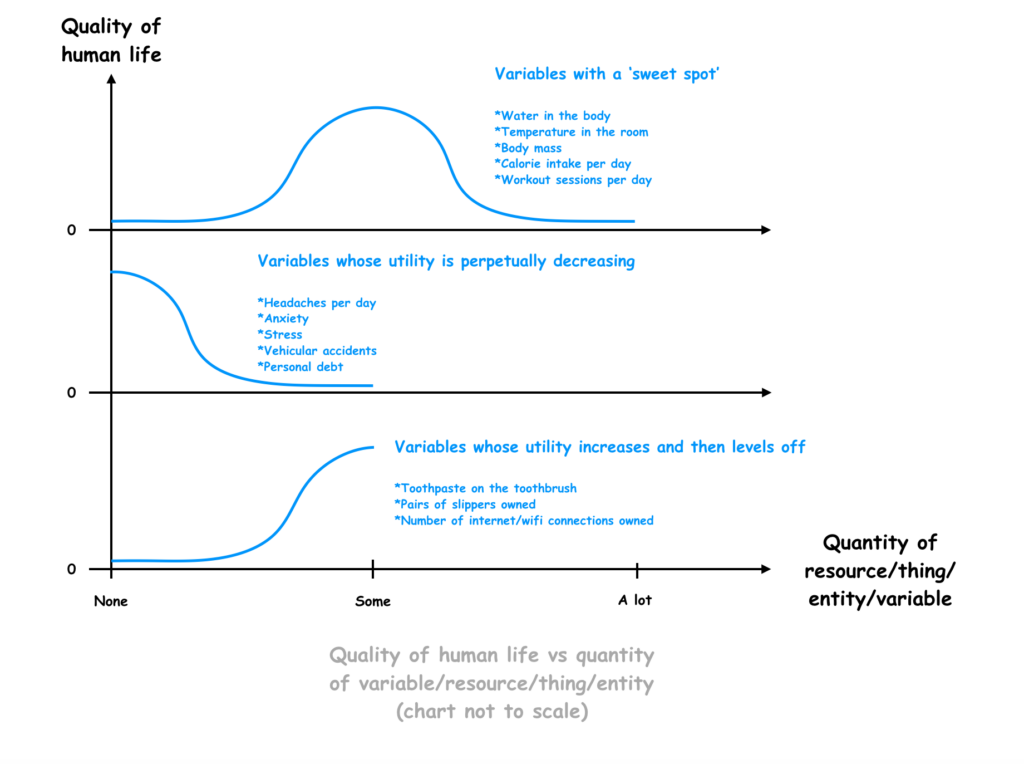It’s fascinating to realize how we all exist on the edge of a razor sharp celestial knife when it comes to what made human life possible on earth in its current form. It’s as if there exists a cosmic ‘life-balancer’, similar to the classic Winamp MP3 EQ/equalizer from the late 90s/early 2000s. Except that in our ‘life-balancer’, there’s a lot more than just audio frequency isolation and adjustment that can be controlled.
At the risk of oversimplification, let’s assume that the below charts encapsulate some key variables needed to define the existence of carbon-based living forms, of which human beings are a subset. It’s interesting to see how Earth provides a warm and cozy sweet spot for us to exist in – temperature, ozone composition in the atmosphere, water, temperature, and distance from the sun. Some scales are only non-negative, while others have both positive and negative axes.

Something as insignificant (on a cosmic scale) as a 23.5 degree tilt in Earth’s axis relative to its orbit causes something as significant as the annual seasons that we know – we are truly tiny and insignificant, a beautiful and hilarious cosmic fluke.
Similar story for Earth’s atmospheric composition with respect to ozone…

… and water on Earth’s surface.

Almost everything that we observe in nature has some ‘range’, and is not binary. At a macro level, not a lot is truly as binary as black and white – everything operates in grayscale. Darkness and light aren’t really antonyms; they’re just different points along the same axis of photons – ‘light’ is the presence of photons and ‘darkness’ is just the absence of them. Same as how coldness isn’t the opposite of heat; it’s the absence of it.
It’s all about levels – a dearth of something can be troublesome but so can its excess – for example, water, oxygen, and food in the body. It’s fun for me to periodically define (and redefine) what those levels or ‘green ticks’ should be for me, instead of always attempting to just ‘increase’ or ‘decrease’ the value of a variable monotonically.
Progress or motion often comes with the absence of ‘bad’ things – stress, bad health, headaches – instead of always due to the presence of ‘good’ ones – access to the most expensive hospitals, most effective analgesics. In fact, often, reducing the ‘bad’ thing in life negates the need for an excess of a ‘good’ thing – don’t need to have a lot of money to spend in a hospital if you’re healthy!
Of course, these are oversimplified examples, and actual reality is a cocktail of all these variables interacting in ever evolving ways. But I think the micro-summary is helpful – we should always have a bird’s eye view and be aware that mostly all such ‘variables’ have ‘levels’ that can dialed up or down, with some effort, to optimize for quality of life. And doing a thought experiment/exercise to recalibrate these variables every few months is probably a good reality check for life priorities.
When we change the value of a variable, say, a non-negative variable such as weight, the same variable’s meaning changes drastically depending upon where we are at an absolute scale – 40kg down and I’m anorexic; 40kg up and I’m obese.
When we say ‘everything is good in moderation’, we’re just defaulting to an implicit understanding of what the variable’s quantity should be in our human scale to optimize for quality of human life as we know it [4].
Things that we can explicitly control in life follow a similar trajectory – not much is truly binary, and mostly everything operates on a scale of varying usefulness/utility. And it’s almost always worth it to try and achieve improvement in life quality by deleting ‘undesirables’ instead of trying to force in more ‘desirables’ to counter the ‘undesirables’. There is a good chance that this approach will be less resource intensive – money, time, health, or effort.
I can categorize most variables we can control in life in one of three ways depending on how their usefulness/utility changes as we change their values:
- Variables with a ‘sweet spot’: pretty self-explanatory – anything in this category above or below the desired ‘sweet spot’ is probably a bad idea and not good for you. This category includes mostly everything, and hence ‘everything is good in moderation’.
- Variables whose utility is perpetually decreasing: these are the things you don’t want present in your life, since their presence would usually deteriorate the quality of life.
- Variables whose utility increases and then levels off: these are things that are good to have in some limited quantity, but anything beyond that is pretty pointless in improving the quality of life. In other words, these are things that offer minimal incremental benefits beyond a certain point.
If you think about it, cases #2 and #3 are just special cases of case 1, adjusted for the human scale. Take a look at some charts to explain this concept a bit more.

All actions are (or rather, should be) to move the current value of a variable toward the crest of the plot and then possibly slowed down to then focus on other priorities. Knowing when to stop is perhaps as important as pushing hard. Given that these variables interact with each other as closely as they do, a slight gain in one can lead to a drastic loss in another.
I present to you the ‘human’ – carefully balanced at the edge of the celestial knife for over 200,000 years [5].
—
Footnotes and sources:
[1] The good concentration of ozone as it exists today is ~ 0.00006% of the atmosphere or ~3B metric tonnes or ~0.6ppm with a peak ~8ppm in the stratosphere. This allows for human life due to life protection from sun’s harmful UV rays, including all of the most energetic UVC radiation, most of the UVB radiation, and about half of the least energetic UVA radiation. Ozone basics from NASA: https://ozonewatch.gsfc.nasa.gov/facts/SH.html#:~:text=Some%20of%20the%20molecules%20that,0.00006%20percent%20of%20the%20atmosphere.
[2] Increased ozone levels, even slightly more than ‘good’ ozone levels, at a delta increase of 70ppb or 0.07ppm in the troposphere for a total of 0.67ppm global average can cause throat irritation all the way to severe asthma with prolonged exposure. And super high levels of ozone (50ppm or higher) are fatal as quickly as after 60 minutes of exposure. Lethal nature of ozone: https://www.cdc.gov/niosh/idlh/10028156.html.
[3] Waterworld movie: https://en.wikipedia.org/wiki/Waterworld. What would happen if the world was covered with water: http://scienceline.ucsb.edu/getkey.php?key=1112#:~:text=If%20the%20rest%20of%20the,would%20go%20extinct%20(die).
[4] We (humans) may look a lot different when we become bio+synthetic beings, or figure out how to transfer consciousness to a silicon/computer chip, etc. In our current form though, human beings are just flesh bags of blood and biological ASICs called organs.
[5] https://www.britannica.com/story/just-how-old-is-homo-sapiens.